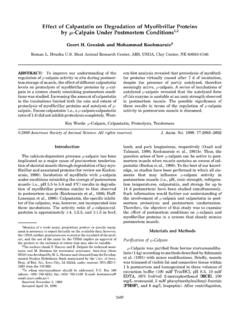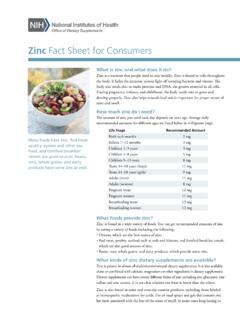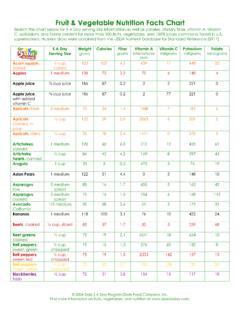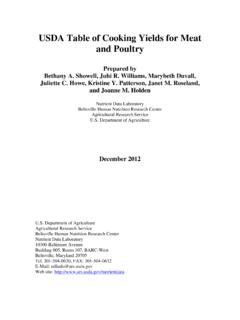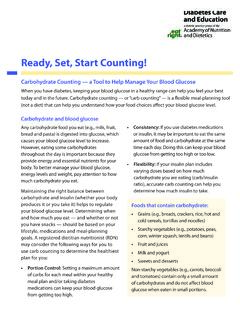Transcription of USDA Database for the Flavonoid Content of Selected …
1 usda Database for the Flavonoid Content of Selected Foods Release Prepared by Seema Bhagwat, David B. Haytowitz, and Joanne M. Holden (ret.). Nutrient Data Laboratory Beltsville Human Nutrition Research Center Agricultural Research Service Department of Agriculture December 2013. Slightly revised, May 2014. Department of Agriculture Agricultural Research Service Beltsville Human Nutrition Research Center Nutrient Data Laboratory 10300 Baltimore Avenue Building 005, Room 107, BARC-West Beltsville, Maryland 20705. Tel. 301-504-0630, FAX: 301-504-0632. E-Mail: Web site: Table of Contents Release i Suggested Citation:.. ii Documentation ..1. Subclasses of flavonoids and Selected compounds ..2. Methods and Procedures used to generate the Database ..2. Data Evaluation ..4. Flavonoid Individual Data Table ..5. Sources of Data ..6. Format of the Tables ..7. food Description File ..7. food Group Description File ..8. Flavonoid Data File ..8. Nutrient Definition File.
2 9. Sources of Data Link File ..9. Sources of Data File ..9. Flavonoid Individual Data File ..10. References Cited in the Documentation ..12. Chemical structures of flavonoids ..13. usda Database for the Flavonoid Content of Selected Foods ..16. Sources of data ..99. Release History Release 1 (March 2003) Flavonoid Content of 225 foods items. Release 2 (August 2006) Flavonoid Content of 392 foods items. Release (January 2007) Flavonoid Content of 385 foods [Eliminated the unusually high gallocatechin values from Cacao (NDB No. 97034, Nutrient No. 794) and all the data for the chocolate items (NDB No. 99388, 99389, 99390, 99390, 99391, 99392, 99407, and 99408]. Release 3 (September 2011) Flavonoid Content of 500 food items Release (June 2013) Flavonoid Content of 506 food items. Data were added for several different types of table olives and olive oils plus additional data on blueberries (rabbiteye). A number of values were revised, due to errors arising from the use of incorrect conversion factors used or the failure to convert some values to the appropriate units.)
3 More detail is provided in the documentation ( ). A table of Individual Data as reported in the original references is also released along with the Release i Release (December 2013) The description for raw cowpeas was changed to reflect the fact that the food was immature cowpeas and not mature cowpeas. As a result, the NDB No. 16062 was changed to 11191 and the food group was changed accordingly. The description for cooked eggplant was changed to reflect the fact that the sample analyzed was actually long eggplant. Since this is a different type of eggplant, the NDB No. was changed from 11210 to 99661. The description for cooked mustard greens was changed to reflect the fact that sample analyzed was actually black mustard greens. Since this is a different type of mustard greens, the NDB No. was changed from 11271 to 99662. NDB No. 99401, Olive leaves, was removed. May 2014 Update: Data for Green tea, brewed (NDB No. 14653) have been restored.
4 Suggested Citation: Bhagwat, S., Haytowitz, Holden, (Ret.). 2014. usda . Database for the Flavonoid Content of Selected Foods, Release Department of Agriculture, Agricultural Research Service. Nutrient Data Laboratory Home Page: ii Documentation for the usda Database for Flavonoid Content of Selected foods, Release (2013). The scientific community continues to take interest in the types and levels of flavonoids in foods because of the consistent evidence regarding beneficial health effects of dietary flavonoids . flavonoids , particularly flavan-3-ols and proanthocyanidins, have been associated with reduction in the risk of cardiovascular disease by modulating various mechanisms of primary and secondary prevention (Schroeter et al., 2010). Anthocyanidins may also protect LDL cholesterol oxidation through their high antioxidant activity (Erdman et al., 2007). Evidence supporting cancer prevention effects of flavonoids is limited and conflicting, but some organ-specific associations have been reported.
5 Lam et al., (2010) observed an inverse relationship between quercetin-rich food intake and lung cancer in a case-control study in Lombardi region of Italy, while Ekstr m et al., (2011) observed protection against stomach cancer with high intakes of quercetin in a population study in Sweden. A large volume of analytical data on food flavonoids has been published since the second release of the usda . Database for the Flavonoid Content of Selected Foods in January 2007, on Nutrient Data Laboratory's (NDL) Web site: Relevant articles published between the second release and the end of 2010. were retrieved and reviewed. One hundred new articles containing data on 26. Selected commonly occurring compounds in the five subclasses of the dietary flavonoids were retained for critical evaluation of data quality. The additional valid analytical data were merged with the data included in the updated Database released in 2007. After review and statistical analysis, approximately 115 new foods were added into the Release 3 of the updated Database .
6 Values were added for additional compounds for some foods published in the earlier Database . The updated Database included source documents citing research conducted in the and also in 50 other countries. Release of the flavonoids Database contains data on some new food items - different kinds of table olives and olive oils data from seven articles and additional data on blueberries (rabbit eye) from one article. A number of corrections were also made due to the use of the wrong conversion factors or failure to convert some values reported as mg/kg or mg/L into mg/100g (two articles on wine and one on orange juice). The changes in values due to incorrect conversion factors were very minor and may not have any impact on the final means of the aggregated data. Similarly changes due to unit conversion did not affect the mean values for wines greatly due to large quantity of data available on wines. The mean value for hesperetin in orange juice, raw (NDB.)
7 09206), changed considerably and was reduced to mg/100g from mg/100g. 1. Isoflavones are not included in this Database . A separate Database , the usda - Iowa State University Database on the Isoflavone Content of Foods first released in 1999 was updated in 2008 and released on the NDL web site. Similarly, proanthocyanidins are not included in this Database because a separate Database , the usda Database for the Proanthoycanidin Content of Selected Foods was released on NDL's web site in August 2004. Subclasses of flavonoids and Selected compounds The Database contains values for 506 food items and for 26 predominant dietary flavonoids that belong to the five subclasses reported below: FLAVONOLS: Isorhamnetin, Kaempferol, Myricetin, Quercetin (Figure 1). FLAVONES: Apigenin, Luteolin (Figure 2). FLAVANONES: Eriodictyol, Hesperetin, Naringenin (Figure 3). FLAVAN-3-OLS: (+)-Catechin, (+)-Gallocatechin, (-)-Epicatechin, (-)- Epigallocatechin, (-)-Epicatechin 3-gallate, (-)-Epigallocatechin 3-gallate (Figure 4), Theaflavin, Theaflavin 3-gallate, Theaflavin 3'-gallate, Theaflavin 3,3'-digallate (Figure 5), Thearubigins ANTHOCYANIDINS: Cyanidin, Delphinidin, Malvidin, Pelargonidin, Peonidin, Petunidin (Figure 6).
8 Methods and Procedures used to generate the Database Only those data generated by acceptable analytical procedures are included. Acceptable procedures are defined as those which lead to good separation of Flavonoid compounds ( , column chromatography or high-performance liquid chromatography [HPLC], capillary zone electrophoresis, micellar electrokinetic capillary chromatography). Studies that contained data generated by thin layer or paper chromatography, radioimmunoassay (RIA), pH differential methods or only spectrophotometric quantitation were not retained due to the lack of specificity of these methods. Similarly, values for total flavonoids or only the totals by subclass of flavonoids were not included, as the objective was to collect values for specific Flavonoid compounds. Most of the compounds in food are present in glycosylated forms except for the flavan-3-ols (catechins and theaflavins) which are present either in free forms or as gallic acid esters ( , in tea).
9 However, some of the analytical procedures convert the glycosides into aglycones and thus results are reported as aglycones. Therefore, where the values for individual glycosides were determined, usda scientists converted the glycoside values into aglycone forms using conversion factors based on the molecular weight of the specific compounds to make data consistent across the Database (see example below, p. 5) . The catechins and epicatechins which were reported as gallic acid esters, such as epicatechin gallate, epigallocatechin gallate, etc., are included as such without any conversions. 2. Mean values in the Database are reported as mg/100g of fresh weight of edible portion of food . Values for beverages were adjusted by their respective specific gravities if reported on liquid basis ( mg/ml) to convert them on weight basis (mg/100g). Analytical reports typically provided data for tea as infusions. The practice of preparing tea infusions varies in different countries and according to individual preferences.
10 Therefore, it is difficult to compare Flavonoid data for brewed teas obtained from different sources. Catechin and flavonol contents in tea infusions increased approximately in a linear way relative to the amount of tea leaves used for brewing. Therefore, all infusion values were standardized to 1% infusion (1g tea leaves/100ml boiling water). These values were calculated using the weight of the tea powder in the tea bag (or loose tea leaves) used to make the infusion. Adjustment for brewing time was not undertaken as a majority of tea flavonoids are extracted into the infusion after only short brewing times and do not increase substantially with extended brewing times (Arts et al., 2000; Hertog et al., 1993). Values for tea are given as mg/100g (100ml) of tea infusions (as consumed) and are equivalent to one gram of dry tea. If a value was reported as Trace , that value was calculated by multiplying the LOQ (Limit of Quantitation) by (Mangels et al.)


